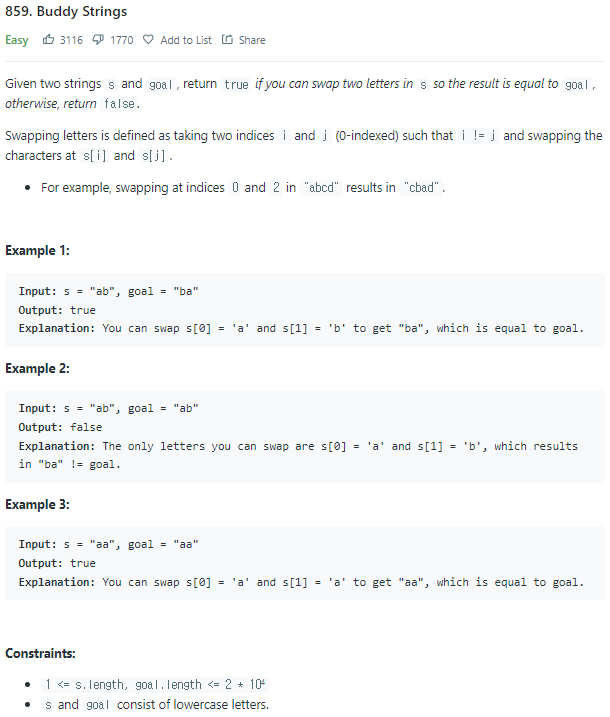문제풀이 - 859. Buddy strings
문제
https://leetcode.com/problems/buddy-strings/
1. 접근
- s와 goal의 문자열 길이는 다를 수도 있다. 다르다면 같아질 일도 없긴 하겠다.
- s의 문자열 길이나 goal의 문자열 길이가 1이 될 수도 있을 것이다.
접근1.
- 두 문자열의 구성요소는 같아야한다.
- 두 문자열이 완전히 동일하다면, 동일한 문자열 간 이동을 해야한다.
- 두 문자열이 다르지만
- 구성요소는 같은 경우
- 두 문자의 위치만 다른 경우 True
- 세 문자 이상의 위치가 다른 경우 False
- 구성요소도 다른 경우 False
- 구성요소는 같은 경우
2. 실수
두 문자열이 다른 부분이 두 군데일 때, s 문자열의 위치를 변경해서 goal 문자열을 만들 수 있는지를 확인하지 않았다.
3. 제출한 답
1
2
3
4
5
6
7
8
9
10
11
12
13
14
15
16
17
18
19
class Solution2:
def buddyStrings(self, source_sentence: str, goal_to_make: str) -> bool:
if len(source_sentence) != len(goal_to_make): #O(1)
return False
different_position_and_value: dict[int, int] = {}
count_of_different_postition = 0
for index in range(len(source_sentence)): #O(n)
if source_sentence[index] != goal_to_make[index]:
if (count_of_different_postition := count_of_different_postition + 1) > 3:
return False
different_position_and_value[count_of_different_postition] = index
if not different_position_and_value: ## 비어있는 경우: 모두 같다
if len(source_sentence) == len(set(source_sentence)): # O(n)
return False
return True
if len(different_position_and_value) == 2:
if source_sentence[different_position_and_value[1]] == goal_to_make[different_position_and_value[2]] and source_sentence[different_position_and_value[2]] == goal_to_make[different_position_and_value[1]]:
return True
return False
시간복잡도
시간복잡도는 O(n)이다.
4. 더 나은 코드
1
2
3
4
5
6
7
8
9
10
11
12
13
14
15
16
class Solution3:
def buddyStrings(self, source_sentence: str, goal_to_make: str) -> bool:
if len(source_sentence) != len(goal_to_make):
return False
mismatched_indices: list[int] = []
for index, char in enumerate(source_sentence):
if source_sentence[index] != goal_to_make[index]:
if len(mismatched_indices) > 2:
return False
mismatched_indices.append(index)
if not mismatched_indices: ## 모든 문자열이 같다
return len(source_sentence) > len(set(source_sentence)) ## source_sentence 문자열 내에 같은 문자열이 있으면 True
if len(mismatched_indices) == 2:
first, second = mismatched_indices
return source_sentence[first] == goal_to_make[second] and source_sentence[second] == goal_to_make[first]
return False
변수명 개선 different_postion_and_value -> mismatched_indices 변수명과 실제 데이터 저장이 안 맞았고, 직관적이지 않았다.
데이터 타입 변경 딕셔너리 -> 리스트 목표하는 문자열과 다른 인덱스 부분을 저장하는 데이터 타입을 변경했다. 어차피 많아야 2개의 값만 들어가는 형태였다.
- range, len -> enumerate
- mismatched_indices의 값을 언패킹해서 변수에 저장
- if - return 에서 return으로 변경
5. enumerate()와 zip()을 함께 사용하기
1
mismatched_indices = [index for index, (source_char, goal_char) in enumerate(zip(source_sentence, goal_to_make)) if source_char != goal_char]
이런 식으로, zip과 enumerate를 함께 쓸 수도 있다. 하지만 도중에 break를 할 순 없다.
참고. itertools 모듈의 takewhile()
itertools 모듈의 takewhile()을 사용하면 특정 조건이 참인 동안만 요소를 처리할 수 있다고 한다. takewhile()은 주어진 조건이 False가 되는 첫 번째 요소에서 반복을 중단한다.
1
2
3
4
from itertools import takewhile
result = [수행할_연산 for item in takewhile(lambda x: 조건, some_iterable)]
6. collections 모듈의 Counter
특수한 딕셔너리 서브 클래스라고 한다.
해시 가능한 객체를 요소로 하는 이터러블(iterable)을 카운트하는 데 사용되며, 주로 요소의 등장 횟수를 딕셔너리 형태로 쉽게 계산해준다. 각 요소는 딕셔너리의 키로, 해당 요소의 등장 횟수는 키의 값으로 저장된다.(내가 하나하나 딕셔너리에 저장해가면서 셀 필요가 없다는 것)
기본 사용법
1
2
3
4
5
6
7
8
from collections import Counter
# 리스트의 요소를 카운트
fruits = ['apple', 'banana', 'cherry', 'apple', 'cherry', 'cherry']
fruit_counter = Counter(fruits)
print(fruit_counter) # 출력: Counter({'cherry': 3, 'apple': 2, 'banana': 1})
주요 기능
요소의 수 카운트
빈도수 상위 요소 찾기: Counter.most_common(n)
가장 빈번하게 등장하는 상위 n개 요소와 그 횟수
수학적 연산
Counter 객체는 덧셈, 뺄셈, 교집합, 합집합과 같은 수학적 연산을 지원
- 요소의 총 개수 얻기: sum(counter.values())
- 단일 요소의 카운트 변경: Counter 객체에서 특정 요소의 카운트를 직접 변경 가능
